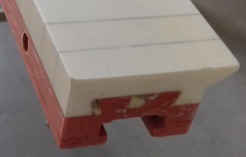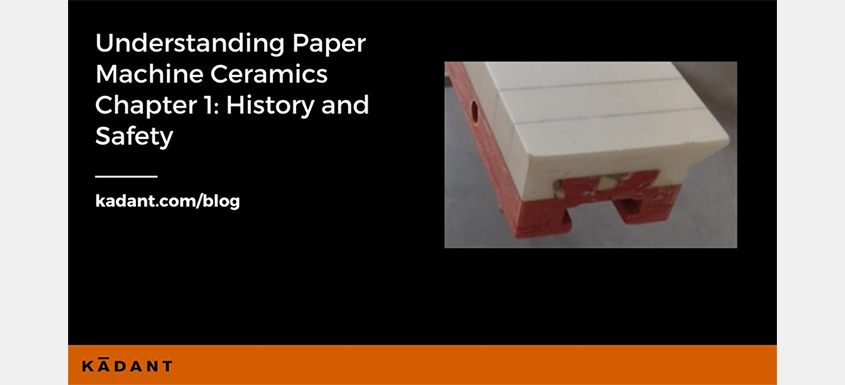The use of ceramics on dewatering elements in the forming and press section of a modern-day paper machine was introduced over 60 years ago.
Ceramics use on paper machines began in the middle 1960s. Ceramics were chosen primarily because they offer superior wear resistance over materials such as polyethylene or Teflon™. Wear resistance is the main driver to overall paper machine performance because it allows the machine to maintain constant process conditions for a longer period. Key factors in the paper making process such as dewatering, and agitation are reduced as blades wear leading to decreased paper quality and production can suffer.
CONSTRUCTION OF CERAMIC BLADES
 Paper machine ceramic blade construction has come a long way since the 1960s when suppliers resorted to many different types and methods for affixing the ceramic segments to a base holder. Today, all suppliers of paper machine ceramic blades have settled on a similar process of bonding the ceramic segments to a pultruded fiberglass resin (FRP) base substrate. The general differences between suppliers are the ceramic shapes used, bonding method and prep, bonding compounds, and the grinding and finishing process. Sourcing of the ceramic segment materials, the bonding compounds, and base substrate are done in an open market so basically every paper machine ceramic blade supplier is buying their materials from the same few sources.
Paper machine ceramic blade construction has come a long way since the 1960s when suppliers resorted to many different types and methods for affixing the ceramic segments to a base holder. Today, all suppliers of paper machine ceramic blades have settled on a similar process of bonding the ceramic segments to a pultruded fiberglass resin (FRP) base substrate. The general differences between suppliers are the ceramic shapes used, bonding method and prep, bonding compounds, and the grinding and finishing process. Sourcing of the ceramic segment materials, the bonding compounds, and base substrate are done in an open market so basically every paper machine ceramic blade supplier is buying their materials from the same few sources.
CERAMIC MATERIAL CHOICES
There are a variety of ceramic materials suitable for paper machines, however the time-tested and proven choices include aluminum oxide (high grade), silicon nitride, and silicon carbide.
Zirconia, once on this list, was considered a premium material because it was the toughest of all ceramics and resisted chipping. However, it has since fallen out of grace with most suppliers because it lacks wear resistance and can sharpen to the knife edge (zirconia is often used to make knives). There are also blended materials still being offered such as aluminum oxide blended with zirconia, a.k.a. toughened aluminum oxide. Blending may sound like a clever idea, but there are pros and cons. In this case toughness and resistance to chipping were improved; however, the wear resistance suffered and was less than that of standard aluminum oxide. Caution should always be taken with any blended materials because the cost of a single issue or failure will outweigh the monetary savings.
HANDLING CERAMIC BLADES
The handling of ceramic blades is often misunderstood and is the root cause of many failures. Ceramic manufacturers take great care in transporting ceramic blades throughout the building, finishing, and packaging processes. Good suppliers use transport dollies and roller tables to move newly constructed blades from set-up to finishing. After finishing, dollies are used to move blades to packaging, where they are supported and cushioned into carefully arranged compartments in the shipping crate. Shipping crates with specially reinforced sides to resist bending are a best practice. Steel reinforced crating is considered the ultimate in protection. Center or single lift points are prohibited, and if lifting options only offer a single pick point then a strongback must be used.
Installation of the ceramic blades onto the paper machine is where compromise most often occurs, which can result in unseen damage exposed months or years later. Blades should always be slid directly out of a crate which is equally supported at 1/3 points across its length. Avoid hand-carrying blades and using ladders or manlifts to raise blades to the installation position. Blades should never be pounded onto tee bars with a mallet or dead weight because it can cause a variety of issues from cracking and chipping to bond failure. Usually issues with poor blade fit, especially if they slide part way onto a machine without issue, are due to tee bar problems, such a build-up of debris or straightness and flatness.
About the Author:

Jim White
Product Line Manager - Forming & Wear Surfaces
Kadant
About Kadant
Kadant is global leader in fiber processing; fluid handling; doctoring, cleaning, and filtration; wood processing systems; and bulk material handling, we design and manufacture products used in industries ranging from paper to plastics and textiles to tires. www.kadant.com














